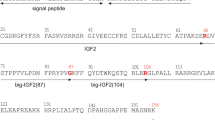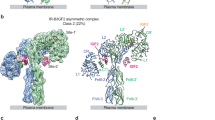Abstract
Somatomedins (SM) or insulin-like growth factors (IGF) constitute a heterogeneous group of peptides1 with important growth-promoting effects in vitro2,3 as well as in vivo4,5. Amino acid sequences have been determined for only two of them, IGF-I and IGF-II, which are highly homologous6,7. IGF-I, which is identical with SM-C8, is composed of 70 amino acid residues and IGF-II contains 73 amino acids and may be identical with SM-A9. Other peptides with different charge properties but with similar SM-like or insulin-like behaviour in biological and receptor assays, have been described but have not yet been fully characterized1. The liver is known to be a major site of production of these peptides10, but many other tissues—especially in the fetus11—may synthesize them as well. We report here the nucleotide sequence of a human liver cDNA encoding the complete amino acid sequence of IGF-I. The IGF-I coding region is flanked by sequences encoding an amino-terminal peptide of at least 25 amino acid residues and a carboxyl-terminal peptide of 35 amino acids. This provides evidence that IGF-I is synthesized as a precursor protein and that formation of IGF-I from this precursor requires proteolytic processing at both ends.
This is a preview of subscription content, access via your institution
Access options
Subscribe to this journal
Receive 51 print issues and online access
$199.00 per year
only $3.90 per issue
Buy this article
- Purchase on Springer Link
- Instant access to full article PDF
Prices may be subject to local taxes which are calculated during checkout
Similar content being viewed by others
References
Van den Brande, J. L. & Hoogerbrugge, C. in Growth Hormone and Other Biologically Active Peptides (eds Pecile, A. & Müller, E. E.) 81–102 (Excerpta Medica, Amsterdam 1980).
Daughaday, W. H. Clin. endocr. Metab. 6, 117–135 (1977).
Clemmons, D. R. & Van Wyk, J. J. J. cell. Phys. 106, 361–367 (1981).
van Buul-Offers, S. & Van den Brande, J. L. in Growth Hormone and Other Biologically Active Peptides (eds Pecile, A. & Müller, E. E.) 103–122 (Excerpta Medica, Amsterdam 1980).
Schoenle, E. et al. Nature 296, 252–253 (1982).
Rinderknecht, E. & Humbel, R. E. FEBS Lett. 89, 283–286 (1978).
Rinderknecht, E. & Humbel, R. E. J. biol. Chem. 253, 2769–2775 (1978).
Klapper, D. G., Svoboda, M. E. & Van Wyk, J. J. Endocrinology 112, 2215–2217 (1983).
Fryklund, L., Uthne, K. & Sievertsson, H. Biochem. biophys. Res. Commun. 61, 957–962 (1974).
Phillips, L. S. et al. Endocrinology 98, 606–614 (1976).
D'Ercole, A. J., Applewhite, G. T. & Underwood, L. E. Devl Biol. 75, 315–329 (1980).
Woods, D. E. et al. Proc. natn. Acad. Sci. U.S.A. 79, 5661–5665 (1982).
Talmadge, K., Stahl, S. & Gilbert, W. Proc. natn. Acad. Sci. U.S.A. 77, 3369–3373 (1980).
Casadavan, M. & Cohen, S. N. J. molec. Biol. 138, 179–207 (1980).
Breslow, J. L. et al. Proc. natn. Acad. Sci. U.S.A. 79, 6861–6865 (1982).
Maxam, A. M. & Gilbert, W. Proc. natn. Acad. Sci. U.S.A. 74, 560–564 (1977).
Maxam, A. M. & Gilbert, W. Meth. Enzym. 65, 499–560 (1980).
Hudson, P. et al. Nature 291, 127–131 (1981).
Hagenbüchle, O., Santer, M. & Steitz, J. A. Cell 13, 551–563 (1978).
Sargan, D. R., Gregory, S. P. & Butterworth, P. H. W. FEBS Lett. 147, 133–136 (1982).
Erni, B. & Stachelin, T. FEBS Lett. 148, 79–82 (1982).
Blobel, G. & Doberstein, B. J. Cell Biol. 67, 852–862 (1975).
Aquaviva, M. A. et al. Diabetes 31, 656–658 (1982).
Vassilopoulou-Sellin, R. & Phillips, L. S. Endocrinology 110, 582–589 (1982).
Craig, R. K. et al. Nature 295, 345–347 (1982).
MacIntyre, I. et al. Nature 300, 460–462 (1982).
Bell, G. I. et al. Nature 282, 525–527 (1979).
Hudson, P. et al. Nature 301, 628–631 (1983).
Smith, D. R. & Calvo, T. M. Nucleic Acids Res. 8, 2255–2274 (1980).
Author information
Authors and Affiliations
Rights and permissions
About this article
Cite this article
Jansen, M., van Schaik, F., Ricker, A. et al. Sequence of cDNA encoding human insulin-like growth factor I precursor. Nature 306, 609–611 (1983). https://doi.org/10.1038/306609a0
Received:
Accepted:
Issue Date:
DOI: https://doi.org/10.1038/306609a0
This article is cited by
-
Glucose lowering effect of transgenic human insulin-like growth factor-I from rice: in vitro and in vivostudies
BMC Biotechnology (2011)
-
Cloning and characterization of class 1 and class 2 insulin-like growth factor-I mRNA in Songliao black pig
Molecular Biology Reports (2009)
-
Insulin and insulin-like growth factor signalling in neoplasia
Nature Reviews Cancer (2008)
-
Effects of α-interferon on insulin-like growth factor-I, insulin-like growth factor-II and insulin-like growth factor binding protein-3 secretion by a human lung cancer cell line in vitro
Journal of Endocrinological Investigation (2005)
-
Thyroid hormone, but not parathyroid hormone, partially restores glucocorticoid-induced growth retardation
Pediatric Nephrology (2005)
Comments
By submitting a comment you agree to abide by our Terms and Community Guidelines. If you find something abusive or that does not comply with our terms or guidelines please flag it as inappropriate.



